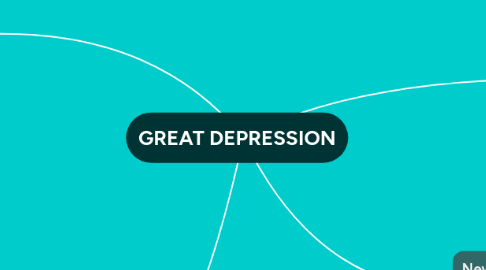
1. Productivity and Unemployment
1.1. purchasing demand has to be present: resulting in high employment and healthy economy
1.2. based on productivity- purchasing power- employment cycle
1.3. 1924-27 productive capacity doubled, but only cus of technological innovation
1.3.1. Overproduction
1.3.1.1. more consumer goods, but not enough ppl to buy them.
1.4. Uneven distribution of Wealth
1.4.1. .1% wealthy ppl owned as much as bottom 42% below poverty line
1.4.2. middle class: not wealthy, depended on salary, when productivity declined, ppl lost their jobs
1.4.2.1. they had to cut back on their purchases this decline in consumption among the middle class ruined the whole country
2. The "Crash" (stock market crashes)
2.1. cause for depression
2.2. ppl invest in companies by buying stocks, in return they get a profit
2.3. Buying on Margin
2.3.1. was a lot of $$ so banks were quick to make loans to stock buyers. N investors only had to pay 10% of the stock's actual value.
2.3.2. Encouraged Stock Speculation
2.3.2.1. ppl wuld buy and sell stocks quickly to make quick money
2.3.2.2. Stock value increased b/c of it
2.3.2.2.1. Companies needed long term investments so they could pay bills (stock value was like an illusion)
2.3.2.2.2. NOT careful traders wuld buy n sell shares intentionally to inflate a given companies stock value.
2.3.2.3. gave a false sense of security
2.3.2.4. Panic Selling
2.3.2.4.1. bottom fell out of market, cus of all ppl trying to sell at one time.
2.3.2.4.2. Ripple Effect
2.4. Economic Cycle
2.4.1. ppl culd not buy=productivity was bad= mor unemployment.
3. Hoover
3.1. Responses
3.1.1. He didn't believe tat the gov. should play an active role in economy
3.1.2. Voluntary Non- Coercive Cooperation
3.1.2.1. he gives tax breaks to bankers/businesses in return for private sector economic investment
3.1.3. organized some private relief agencies for unemployed
3.1.4. worked out a system w/ European powers that owed U.S money as a result of WW1 debts
3.1.4.1. Hoover Moratorium
3.1.4.1.1. put a temporary stop to war debt & reparations payments
3.1.4.2. European countries were to purchase American goods instead to stimulate American economy
3.2. Tariff Wars
3.2.1. Democrats pass a high tariff industry which was supposed to stimulate purchasing of U.S goods
3.2.2. Fatal Error
3.2.2.1. Global Economy
3.2.2.1.1. other countries passed high tariffs and no foreign markets purchased American goods, so U.S productivity decreased again.
3.2.3. Tariff- bill, cost or charge
3.3. Banker's Panic
3.3.1. b/c of Russia's cheap wheat in an attempt to pay back Austrian banks (price was too low and they couldn't)
3.3.1.1. Bank of International Settlement
3.3.1.1.1. Austrian banks borrowed from German banks and appealed to them
3.3.1.1.2. Austrian banks and loaning German banks therefore were forced into bankruptcy
3.3.1.1.3. b/c German banks borrowed from American banks, U.S banks began to go bankrupt, wiping out life savings of thousands of Americans
3.4. Americans React
3.4.1. Reconstruction finance corporation
3.4.1.1. had power to make emergency loans to banks
3.4.2. Rugged Individualism
3.4.2.1. Hoover wouldn't involve himself in any programs of direct gov. aid to individuals
3.4.3. People were frustrated - isolated protest movements
3.4.3.1. EX- Dairy farmers frustrated w/ low price of milk refuse to sell (dump it)
3.4.3.2. Bonus March
3.4.3.2.1. EX- WW2 veterans (pensions discontinued by congress) had a march on Washington
3.5. 1932 Election
3.5.1. 1:4 were unemployed
3.5.2. national income = 50% of 1929's
3.5.3. Republics nominated Hoover vs. Franklin Delano Roosevelt. FDR by a landslide.
